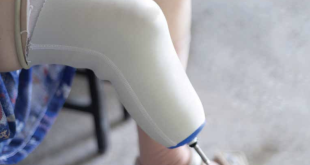 Sarika Koirala
Sarika Koirala
She is a medical student at Kathmandu Medical College and Teaching Hospital. Being a member of Leo Club of Durbarmarg 325-L and Global Surgery Simulation Network, she has been actively participating in health camps, first aid training and awareness campaigns to raise knowledge and to adopt healthier practice in the day to day life relating to various health concerns as well as physiological changes occurring over time. She aims to aid the learning process and bring theory into practice one step at a time.
“Reema Ojha, a 49-year-old woman, says, “I have been experiencing pain in my legs due to bony growths on both my heels since last year.” Before getting treatment, I couldn’t even take one step forward after a busy day due to excruciating pain. Walking and standing for longer periods usually precipitates the pain. I haven’t been able to use footwear of choice due to the pain and require insoles in sports shoes to walk more comfortably. I have been doing physiotherapy that has been helping me get better.”
Another such person suffering from chronic pain recounts her experience saying, “In Shrawan this year, I was suddenly struck by intense joint pain that spread throughout my body. The pain was so overwhelming that simple tasks like walking, chewing, and even breathing became a struggle. Eventually, I collapsed and was rushed to the hospital, where I was diagnosed with Rheumatoid Arthritis. Since then, I’ve been on medication, but I still experience weakness and tingling sensation in my limbs. My grip isn’t as strong as before, and my pace has noticeably slowed. Squat toilets are no longer an option for me. While I’ve grown accustomed to the gentle ache and stiffness in my knees that accompanies every movement, I continue to navigate this journey with resilience.”
Mr. Dahal, currently 58 years old, shared his experience on living with digestive pain issues for decades as: “I’ve had digestive issues since I was 23, starting with frequent loose stools that responded to medication but kept returning. In my 50s, I noticed white mucus in my stool, which subsided temporarily but has persisted for the past year despite treatments. I frequently experience a burning sensation on an empty stomach, loud bowel sounds after meals, and feeling the need to pass stool frequently. About two years ago, acid reflux began disturbing my sleep, waking me with sour liquid in my throat. I was recently diagnosed with chronic esophagitis and gastritis. To manage my condition, I’ve long avoided fast food, red meat, dairy, sugar, and beans.”
A 22-year-old woman who has been experiencing back pain since she was 12, first sought medical attention at 15, where tests revealed a vitamin D deficiency, leading to a one month course of cholecalciferol. When the pain persisted, an X-ray showed a slight deviation in her cervical spine which did not explain the cause for her lower back pain. With no relief from medication, she was advised to follow physiotherapy exercises. She stuck to them for a few months but eventually stopped. Since then, she has not gone for a follow-up and has learned to live with her pain, thus, choosing to neglect it rather than seek further medical help. These are just a few examples, but many others share similar experiences, ultimately leading to the neglect of chronic pain.
Pain is one of the most common symptoms that bring people to the hospital, yet it remains one of the most frequently ignored problem. Often, it is only addressed when it becomes severe or persists long enough to become chronic. Chronic pain is defined as any pain lasting more than three months and despite it affecting one in four people, chronic pain remains widely neglected.
Chronic pain can take many forms, including arthritis, back pain, headaches, neck pain, and neuropathic pain. Conditions like GERD, chronic hepatitis, congestive heart failure, celiac disease, neuralgia, endometriosis can also involve persistent pain but is not limited to just these. The nature of pain varies: dull, aching, burning, shooting, squeezing, throbbing, tingling, or stinging; depending on the underlying cause. Over time, chronic pain can lead to other physical and psychological conditions, such as fatigue, irritability, insomnia, generalized anxiety disorder, and major depressive disorder. These comorbidities further intensify the burden of pain, often trapping individuals in a cycle of suffering.
Despite its prevalence, chronic pain is often overlooked after the first few hospital visits. This is partly because many individuals learn to accept it as a part of their life, especially when no clear underlying cause is found. It can also be associated with the economic burden of long-term medical care. Regular hospital checkups, diagnostic tests, medications, and therapies can become financially draining, especially when no definitive cure is found. Many people, faced with mounting medical expenses and little improvement, choose to endure the pain rather than continue seeking treatment. Over time, they stop seeking medical help, adapting instead to a routine that accommodates their pain rather than addressing it.
In a world driven by productivity and commercial demands, rest is often undervalued, making it difficult for those with chronic pain to prioritize their well-being. The pressure to keep working, stay functional, and push through discomfort forces many to find ways to sustain themselves rather than seek proper treatment. The financial strain, combined with societal pressure to remain productive, often forces individuals to prioritize work over health, further contributing to the cycle of neglect.
Breaking the cycle of chronic pain neglect requires a shift in both societal attitudes and healthcare approaches. Increased awareness, better access to affordable treatment, and a multidisciplinary approach to pain management can significantly improve the lives of those suffering. Encouraging regular follow-ups, providing psychological support, and fostering a culture where rest and recovery are valued rather than dismissed can help prevent individuals from resigning themselves to a lifetime of silent suffering. Chronic pain should not be dismissed; it deserves acknowledgement, attention and intervention.
 Medicosnext
Medicosnext




